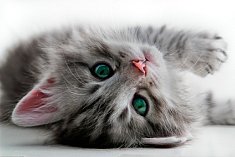|
Feline Skin Problems: Causes, Types And Different Treatments

Whether it’s severe itchy or crusty lesion, cats can be affected by a wide variety of feline skin problems. Many skin problems that affect cats are caused by different factors ranging from poor nutrition to environmental factors. Skin problems should always be diagnosed and treated by your cat’s veterinarian, to reduce the chances of the condition developing into a serious cat health problem.
Causes
Infections, parasites, fungus, allergies, environmental factors, allergies, and stress can all cause feline skin problems. Infections that are caused by bacteria can cause your cat’s skin to become inflamed, dry, itchy and develop redness in the affected areas. Parasites such as ringworms, lice, ear mites and fleas are usually very contagious and can easily cause you cat’s skin to be irritated and uncomfortable. Environmental factors that can negatively affect your cat’s skin include excessive exposure to both heat and cold. Some cats experience feline food allergies to certain types of food, the most common cat food allergies include wheat gluten, soy, beef, lamb, seafood, corn and dairy products. Your cat's food allergies may result in small red or crusty lesions on their skin. Stress has also been linked to causing feline skin problems due to the fact that cats that are stressed out may obsessively lick and even chew at their skin, causing bald spots and possibly damaging their skin.
Symptoms
Symptoms of feline skin problems include;
Symptoms can also vary depending on the particular type of skin problem.
Types of Feline Skin Problems and Treatments
Feline skin problems can sometimes cause cat owners to feel helpless meanwhile waiting for their veterinarian to find out which skin problem their cat’s may be suffering from. Skin problems are sometimes difficult for vets to diagnose due to the fact that they have many of them have very similar symptoms, and you cat may be experiencing more than one skin problem at the same time.
Some of these skin conditions include flea infestation or mosquito bite sensitivity, feline acne, bacterial infections, yeast infections, ringworm, sporotrichosis, allergic dermatitis, alopecia, ear mites, lice, and hyperplasia.
Flea infestation or mosquito bite sensitivity occurs when your cat is highly sensitive to the saliva or bites of fleas and/or mosquitoes. Cats do not usually react the first time they are bitten. If your cat has been bitten by a flea or insect, your vet will prescribe cat flea treatment medication that can drastically reduce the itchy symptoms that these bites can cause. Without treatment, these bites can lead to skin infections.
Feline acne can be a result of stress, poor grooming or an allergic reaction to medication. It typically causes lesions and abscesses to form on the chin and surrounding areas. Your cat's veterinarian may recommend a medicated shampoo to clear up your cat’s skin. In some cases, antibiotics can be prescribed, but only if the acne is being caused by an underlying bacterial infection.
Bacterial infections affect the superficial layers or even the deeper layers of your cat’s skin and can cause feline skin problems. These infections can start out as a minor cut on your cat’s skin and escalate to an infection. If your cat suffers from a fungal infection, he/she is also at an increased risk for developing a bacterial infection. Your vet will usually prescribe antibiotics to treat a bacterial infection. Yeast infections are caused by a fungus and usually affect your cat’s ear. Symptoms include black or yellow discharge, persistent itching and redness of the affected area. This type of infection is usually cleared up with a round of antifungal medication. Ringworm is fungal infection that can result in feline skin problems.Symptoms include itchy lesions, usually located on the head, ears and forelimbs. The marks are circular with a bald area in the center, thus the name ringworm. Ringworm is highly contagious and requires treatment right away with antifungal medication. Ringworms are treated by either a oral or topical cream treatment or a combination of both, depending on the severity of the infection.
Sporotrichosis is a type of infection that is caused by a fungus. The fungus is found in soil, hay, moss and other plants. The lesions often occur on your cat’s head, legs, and tail. It is often transmitted through a small cut in the skin after coming in contact with vegetation containing the fungal spore. It is highly contagious to both animals and humans. Sporotrichosis is usually treated through oral potassium iodide., the treatment usually lasts 4 to 8 weeks. It’s important to treat all cuts even minor ones that your cat may get, to help to prevent this infection.
Allergic dermatitis is triggered by different allergens, which included dust, grass, weeds, certain foods, or fleas. The allergic reaction doesn’t usually occur during the first exposure to the allergen. It takes time for your cat’s body to develop an allergic reaction which sometimes resulting in inflamed, itchy skin. The most common allergen that causes this reaction is flea bites. Treatment of allergic dermatitis depends on what allergens your cat is reacting to and the severity of the reaction. Antihistamines, medicated shampoos or topical ointments may be prescribed to treat the condition.
Alopecia is a feline skin problem that results in shredding hair and hair loss. This condition is often caused by flea bite sensitivity. Often times, your vet will check your cat’s skin and hair for flea excrement, which is red or brown, to determine if fleas may be the cause of the cat’s symptoms. Treatment for alopecia depends on the cause, if it’s due to a skin problem or hormonal imbalance; your vet will prescribe either oral or topical medications to treat the condition. If the alopecia is a result of a behavioural problem, your vet will assist you with behavior modification to stop your cat from participating in the behavior that is resulting in their condition.
Feline ear mites are parasites that can travel into your cat’s ear, living off of the cat’s blood. Without treatment, ear mites can live in the cat’s ears for their entire life cycle and continue to multiply, leading to an infestation and making the cat susceptible to skin infections. Treatment includes cleaning the affected area and applying ear mite medication for about a week or until the condition has cleared up.
Lice are another parasite that cats can catch from other cats. The species is different though, so humans cannot catch feline lice. The occurrence of feline lice is actually very rare. The eggs, or nits, are clear and can be seen attached to your cat’s hair or skin. Treatment may involve the bathing your cat with an insecticide shampoo. Tail Gland Hyperplasia, also known as stud tail, causes greasy, matted hair. This ailment affects the sebaceous glands, which provide lubrication the skin. When these glands don’t produce enough oils, the skin can become irritated and dry, especially around the base of the tail. This condition tends to affect male cats more often than female cats. Treatment may include giving your cat a bath with antiseborrheic shampoo. If your cat isn’t already spayed or neutered, your vet may recommend doing so in order to help alleviate the condition.
Stress
Cats experience stress for a variety of reasons, they could be stressed due to a new family member, new pet or a big move. As a result of the stress they may begin to excessively groom and chew at their skin and express other cat behavior problems.
As humans we know that life will always come with a bit of stress, an even good moments like a new baby comes with a dose of stress; however our cats like the predictability of routine. During stressful times, it’s important to give your cats a bit more attention, whether it’s through extra play time or additional petting sessions. Buying commercial products like feliway, which is designed to offer a bit of relaxation to your cat, helps to calm them down through those moments of extra stress
Similar Topics
Feline Eye Infection: Causes And Effective Treatments - Discussing different types of feline eye infections, causes and treatment options.
Common Elderly Cat Health Problems - Discussing several different health problems that affect senior cats and treatment options.
Cat Anatomy: Interesting Facts About Your Cat's Body - Understanding your cat's anatomy will help you better understand your cat. Discussing your cat's senses, body and digestive system.
Feline Hair Loss: Causes, And Different Treatment Options - This article discusses the many different causes and effective treatment options for feline hair loss.
Return From Feline Skin Problems To Cat Health Home Page
|
Protect Your Pet Card
In Case Of An Emergency The Protect Your Pet Card Lets Emergency Services Know That You Have Pet/Pets Waiting For You At Home, Making Sure That Your Pets Are Cared For.
Get Your Card Today!
Win A Free $250 Petsmart Gift Card For Your Cat!
Must Be A US Resident
Click Here To Easily Enter For Your Chance To Win.

"There are few things in life more heartwarming than to be welcomed by a cat."






